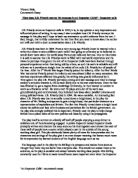Emma Brittain. 10.6
How does Priestly show the inspector to be more than just an inspector?
What did 'An Inspector calls`' audience want? It was 1946- they wanted post-war entertainment, they wanted mystery, suspense and macabre murders. That got it in the form of this timeless play. And with the thrill it gave, it tuned its audience back to seeking amusement from theatre, rather than from the more modern cinemas, which was part of the play's purpose. Its purpose was rather more to bring attention to Priestly's moral views. In the form of Inpector Goole, Priestley shows his audience that socialism should be taken serisously as, one by one; The Inspector converts each character into taking responsibility. 'An Inspector calls' is a prime example of a late 1940s detective thriller, and it delivers a strange feeling of intriguing guilt and responsibility that Priestley wishes upon the audience.
Firstly, the inspector's name itself, Goole, suggests something over-worldly, because of it's likeness to the word Ghoul, meaning spectre, which links to the girls state and gives the inspector a somewhat seemingly grave quality. The Inspector's appearance, as said in the book, creates at once "at once an impression of massiveness solidity and purposefulness" This, to me, implies purposefulness beyond his own police duties, and he remains strong and solid as described throughout. The timing of his appearance is also significant. He arrives just at the point Birling is lecturing to his family "a man has to mind his own business and look after himself and his own and-". Priestley has written that he is to arrive at this point to show that the inspector is to position himself in the way of Birling's message and shows the characters that what he has said is not true, because what he believes is the opposite and stands strong against Birling.
How does Priestly show the inspector to be more than just an inspector?
What did 'An Inspector calls`' audience want? It was 1946- they wanted post-war entertainment, they wanted mystery, suspense and macabre murders. That got it in the form of this timeless play. And with the thrill it gave, it tuned its audience back to seeking amusement from theatre, rather than from the more modern cinemas, which was part of the play's purpose. Its purpose was rather more to bring attention to Priestly's moral views. In the form of Inpector Goole, Priestley shows his audience that socialism should be taken serisously as, one by one; The Inspector converts each character into taking responsibility. 'An Inspector calls' is a prime example of a late 1940s detective thriller, and it delivers a strange feeling of intriguing guilt and responsibility that Priestley wishes upon the audience.
Firstly, the inspector's name itself, Goole, suggests something over-worldly, because of it's likeness to the word Ghoul, meaning spectre, which links to the girls state and gives the inspector a somewhat seemingly grave quality. The Inspector's appearance, as said in the book, creates at once "at once an impression of massiveness solidity and purposefulness" This, to me, implies purposefulness beyond his own police duties, and he remains strong and solid as described throughout. The timing of his appearance is also significant. He arrives just at the point Birling is lecturing to his family "a man has to mind his own business and look after himself and his own and-". Priestley has written that he is to arrive at this point to show that the inspector is to position himself in the way of Birling's message and shows the characters that what he has said is not true, because what he believes is the opposite and stands strong against Birling.








